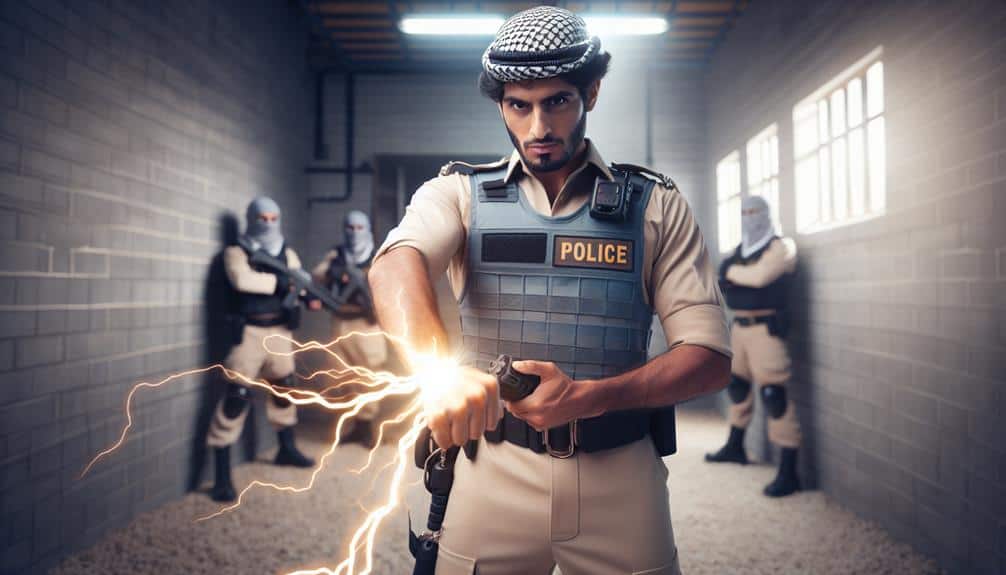Empower Your Defense: Mastering Stun Gun Techniques

You’ve got a stun gun, and it’s like having a superpower in your hands. To activate it, find the on-off switch, then press the activation button and aim for key spots like the upper hip, shoulder, or below the ribcage. Remember, it’s all about making contact and maximizing impact. Practice makes perfect, so get comfortable with its switches to avoid any “shocking” surprises. Stay sharp, agile, and know the legalities in your area—no one wants a hero in handcuffs. Curious about the best ways to employ and evade, or how cops train? There’s a lot more to discover!
Understanding Stun Guns
Stun guns are powerful self-defense tools that can incapacitate an attacker with a quick electric shock. When you think about safety, these devices pack a punch, giving you that much-needed peace of mind. Law enforcement, including police officers, often rely on stun guns for non-lethal interventions. They’re designed to disrupt muscle function through high-voltage, low-amperage electrical shocks, making it hard for anyone to move. Imagine the relief of having a tool that can stop someone in their tracks!
These gadgets aren’t just for the pros, though. You can easily carry one for personal safety. They’re user-friendly, affordable, and many come with built-in LED flashlights. Picture yourself walking through a dimly lit parking lot, feeling a bit on edge. With a stun gun in hand, you’ve got both a light and a safety device ready to go. It’s like having a reliable sidekick!
But remember, it’s important to understand the legal considerations and safety measures. Knowing where to aim and how to use the stun gun properly can make all the difference. So, explore the details, get familiar with your tool, and stay safe out there!
Activation Process
Now that you understand the basics of stun guns, let’s look at how to activate one effectively. First, locate the on-off switch and set it to the active position. This step is essential because, without it, your stun gun is just a fancy paperweight. Next, identify the activation switch, which is usually a button or trigger. This is your lifeline, so get familiar with it.
Imagine the activation process in this simple table:
| Step | Action |
|---|---|
| 1. Locate | On-off switch |
| 2. Set | Switch to the active position |
| 3. Identify | Activation switch |
| 4. Engage | Press the activation switch |
| 5. Contact | Direct contact with attacker |
Unlike pepper spray, which can cause permanent eye damage, a stun gun gives you a non-lethal edge. For maximum effect, aim for the upper hip, shoulder, or below the ribcage. If you’re in a pinch and can’t target these areas, don’t worry—any contact point will do. A solid 5-second zap can induce serious confusion and disorientation in your attacker.
Key Target Areas

When aiming for key target areas, focus on the upper hip, shoulder, or below the ribcage to maximize the stun gun’s impact. These spots are prime impact zones that enhance the device’s effectiveness, thanks to their rich nerve clusters. So, when you’re in a defensive stance, make sure your precision targeting aims for these spots.
Imagine this: you’re in a tense situation, adrenaline pumping, and you’ve got to act fast. Aiming for these key areas ensures that your strategic strikes hit home. The upper hip, shoulder, and below the ribcage are spots that can disorient and incapacitate an attacker. It’s like hitting a bullseye every time!
But let’s talk body mechanics. You need to adapt to the attacker’s movements to ensure effective contact. If the perfect spot is out of reach, don’t worry. Utilize any available contact points. The key is to be flexible and ready to strike where you can.
Safety Measures
While mastering key target areas is essential, making sure you handle your stun gun safely is just as vital. You don’t want to accidentally zap yourself or someone else when you least expect it. So let’s delve into some key safety precautions to keep in mind.
First off, always keep your stun gun in its deactivated mode when you’re not using it. This simple step goes a long way in preventing accidents. Imagine the awkwardness of explaining to your friends why you zapped yourself in the leg!
Next, familiarize yourself with the on-off switch and activation switch. Understand how they work so that you can avoid mishaps. You don’t want to be fumbling with switches in a high-pressure situation.
Lastly, handle your stun gun responsibly. Being cautious and following proper procedures for activation and deactivation can prevent self-activation and ensure your safety.
Here are some quick tips to remember:
- Deactivate when not in use: Keeps you and others safe.
- Know your switches: Avoids confusion and potential danger.
- Handle with care: Prevents unintentional activation.
Escape Strategies

When you use a stun gun, your main goal is to create a chance to get away safely. Quick evasion tactics, like sudden sprints or zigzag movements, keep you unpredictable, while defensive body movements help you stay ready and alert.
Effective distraction methods, like throwing an object or shouting, can also confuse your attacker, giving you precious seconds to escape.
Quick Evasion Tactics
Mastering quick evasion tactics involves using the stun gun’s disorientation effect to swiftly create a safe escape route. When you zap your attacker, they’re momentarily stunned, giving you a golden chance for a speedy retreat.
Picture this: you’ve just used your stun gun, the assailant is reeling, and now’s your moment for a sudden departure.
Here’s how you can master these quick evasion tactics:
- Plan Your Exit: Always have an escape route in mind. It’s like knowing the fire exits in a building. If you know where to go, you can make a swift evasion without hesitation.
- Stay Alert: During those critical seconds when the attacker is disoriented, keep your eyes wide open. Look for clear paths or open doors, and don’t let panic cloud your judgment.
- Create Distractions: Sometimes, making noise or throwing something can further disorient the attacker, giving you more time for a speedy retreat.
Defensive Body Movements
After executing quick evasion tactics, it’s critical to use defensive body movements to maintain distance and further disorient your attacker. You need to master techniques like sidestepping, blocking, and pivoting. These maneuvers will keep you safe and confuse your attacker. Imagine you’re dancing, but instead of a graceful partner, you’ve got a dangerous foe.
By combining evasive techniques with stun gun synergy, you create a powerful defense. Think about how you can sidestep to the left, block any incoming strikes, and pivot to a new position. This constant movement makes it hard for your attacker to predict your next move, keeping them off balance.
| Defensive Maneuver | Effect |
|---|---|
| Sidestepping | Helps in distance creation |
| Blocking | Prevents attacker’s advances |
| Pivoting | Enhances attacker disorientation |
| Backpedaling | Increases distance rapidly |
| Feinting | Confuses attacker’s focus |
Distance creation through these body movements buys you precious seconds to activate your stun gun. Keep practicing these escape strategies until they become second nature. That way, when you’re in a real situation, your body knows exactly what to do. Remember, the goal is to outmaneuver your attacker, giving you the upper hand in any confrontation.
Effective Distraction Methods
Utilizing the sudden disorientation caused by a stun gun, you can create a critical window for a swift and effective escape. When your attacker is momentarily confused, you’ve got a golden opportunity to get away safely. Picture it: one zap and they’re dazed, giving you those precious seconds needed to execute your escape plan.
To make the most of this moment, keep these key points in mind:
- Distraction techniques and tactical advantages: Use the stun gun’s shock to divert their attention. As they reel from the jolt, take a deep breath and focus on your next move.
- Disorientation benefits and escape plans: While they’re off balance, quickly scan your surroundings. Identify clear paths and exits, and don’t hesitate—move swiftly.
- Swift evasion and defensive maneuvers: Practice defensive maneuvers regularly so you can react instinctively. Run in zigzags if necessary, and make noise to attract attention.
Responsible Usage
To guarantee safe handling, always keep your stun gun deactivated when it’s not in use. Proper handling is essential. You don’t want any accidental zaps, right? Understanding the on-off switch and activation mechanism is your first step towards responsible ownership. This way, you won’t end up shocking yourself or others unintentionally.
Imagine this: you’re in a tense situation, and your stun gun’s ready to go. You definitely don’t want it going off in your pocket! Practice caution. Prioritize safety to avoid accidents. When you know your stun gun inside and out, you’re more confident and prepared.
Now, let’s talk about proper targeting areas. Aim for spots like the upper hip, shoulder, or below the ribcage. These places are ideal for creating that important disorientation effect, giving you a chance to escape safely. Remember, the goal is to protect yourself, not to harm others unnecessarily.
Owning a stun gun is a big responsibility. Treat it with respect, and it’ll be a valuable tool in your defense arsenal. So, keep it deactivated when not in use, handle it properly, and always be mindful of safety. You’ve got this!
Legal Considerations

When it comes to stun guns, you’ve got to know the local rules and restrictions, or you might find yourself in hot water. Some states require permits, while others have strict carry laws, so understanding these details is essential.
Hawaii and Rhode Island have their own quirks, making it even more important to stay informed and compliant.
Local Regulations and Restrictions
Understanding the intricate terrain of state-specific stun gun laws is essential for making sure you stay on the right side of the law. Exploring these regulations can feel like walking through a maze, but it’s vital to keep yourself informed. Each state has its own set of rules regarding stun gun ownership, and missing a detail could land you in hot water.
Let’s break down some key points to help you comprehend your legal responsibilities.
First, be aware of state regulations concerning ownership. Some states have very strict rules, while others are more lenient. Knowing where your state stands is the first step to staying compliant.
Second, familiarize yourself with any permit requirements and restrictions. Some states might require you to obtain a permit, while others don’t. Understanding these specifics will help you avoid any legal pitfalls.
Finally, remember that legal compliance is your responsibility. It’s up to you to make sure you’re following the rules and regulations set forth by your state. Ignorance is no excuse in the eyes of the law.
State regulations: Vary widely, affecting ownership laws.
Permit requirements: Some states have them, others don’t.
Legal compliance: Always your responsibility.
Stay vigilant, stay informed, and you’ll be empowered to use your stun gun responsibly.
Permits and Carry Laws
Understanding the maze of permits and carry laws for stun guns is essential to guarantee you’re legally protected and compliant. Exploring this terrain can feel like solving a puzzle in the dark, but don’t worry, we’ve got your back!
First off, permit requirements and concealed carry laws differ from state to state. Some states let you carry a stun gun without any hassle, while others have strict state regulations. You’ve got to know your ownership rights and make sure you’re in line with legal compliance. Self-defense laws can be tricky, so it’s vital to get familiar with your local rules.
Here’s a quick look at how various states stack up:
| State | Permit Required? | Concealed Carry Allowed? |
|---|---|---|
| California | Yes | No |
| Texas | No | Yes |
| New York | Yes | No |
| Florida | No | Yes |
| Illinois | Yes | Yes |
These variations make it super important to check your state’s specific laws before you buy or carry a stun gun. You wouldn’t want to get in trouble just because you missed a tiny detail. So, stay informed, stay safe, and keep those self-defense tools at the ready. After all, knowledge is power, right?
Overcoming Challenges
Mastering the challenges of deploying a stun gun in close-range combat requires quick thinking and adaptability. Imagine you’re face-to-face with an attacker. Your heart’s racing, and you need to act fast. Close range techniques are vital here. Aiming for large muscle groups like the thighs or shoulders guarantees effective contact, but what if you can’t reach those areas? Adaptation is key.
Tactical positioning can make all the difference. Position yourself slightly off-center to the attacker, reducing their ability to strike you directly. This positioning not only gives you room to maneuver but also keeps you ready for counterattack strategies if things go south. Quickly evaluating the situation and positioning yourself can turn the tide in your favor.
Here are some quick tips to keep in mind:
- Adapt to the attacker’s movements: Don’t just stay static; move with them to maintain contact.
- Utilize alternative contact points: If the primary targets aren’t feasible, go for the ribs or even the neck.
- Plan an escape route: Once you’ve deployed the stun gun, use the attacker’s disorientation to get away fast.
Stun Guns in Law Enforcement

When you think about stun guns in law enforcement, it’s all about using them effectively and safely. Officers need excellent training and certification to handle these tools, ensuring they can neutralize threats without causing unnecessary harm.
This training is essential because, let’s face it, no one wants a shocking surprise during a tense situation!
Effective Deployment Strategies
To deploy stun guns effectively, officers need thorough training and strict adherence to department policies. Mastering the art of tactical positioning and strategic deployment is key.
You’ve got to stay aware, understanding the situation to use the stun gun effectively. It’s not just about having the tool; it’s about knowing when and how to use it.
Picture yourself in a tense scenario. Your situational awareness kicks in, and you’ve got to think on your feet. Recognize the moment for effective utilization, when de-escalation is significant. Your goal is precision targeting, aiming for rapid incapacitation without causing permanent harm. It’s a dance between being firm and being cautious.
Here are some key points to keep in mind:
- Tactical positioning: Always be aware of your surroundings and position yourself for the best outcome.
- Strategic deployment: Use your stun gun wisely, ensuring it’s the right tool for the situation.
- Precision targeting: Aim accurately to incapacitate quickly without causing unnecessary harm.
Training and Certification
After understanding effective deployment strategies, it’s essential that law enforcement officers receive specialized training and certification to use stun guns properly.
You can’t just hand over a stun gun and expect magic. Officers need enhanced skills and tactical training to ensure they’re prepared for anything.
First off, the certification process is no joke. It’s designed to provide officers with the know-how to deploy stun guns in line with department protocols. They dive deep into legal guidelines, so they’re crystal clear on what’s allowed and what’s not. And of course, they master proper deployment techniques. We’re talking about knowing exactly when and how to use it for the best outcome.
Regular re-certification is a must too. It’s like a refresher course, ensuring officers stay sharp and don’t get rusty. This ongoing training makes sure they’re at the top of their game, ready to handle potentially dangerous situations while minimizing harm.
Think of it as a tune-up for your car, but way more vital.
Traveling With Stun Guns
Traveling with stun guns requires careful planning and compliance with regulations to guarantee a hassle-free journey. When flying, follow airport regulations by packing your stun gun in checked baggage, not in your carry-on.
Different countries have different rules, so if you’re engaging in international travel, double-check the regulations for your destination.
To keep everything safe and secure, use locked cases or built-in safety mechanisms. This prevents accidental discharges and keeps everyone safe. Plus, it shows you’re responsible and prepared, which is always a good look.
When crossing borders, whether state or national, inform the authorities about your stun gun. This ensures you meet all legal requirements and avoid any unpleasant surprises.
Here are a few tips to keep in mind:
- Check with TSA: Stun guns are allowed in checked baggage but not in carry-ons.
- Research international rules: Different countries have different laws; always verify before you travel.
- Use locked cases: Secure your stun gun to prevent accidental discharges.
When you’re well-prepared, you can travel confidently, knowing you’ve got your defense tools ready and that you’ve followed all the necessary steps. Happy travels!
Frequently Asked Questions
How Strong Should a Stun Gun Be for Self-Defense?
For self-defense, select a stun gun with a voltage rating of at least 100,000 volts. Make sure it has a reliable battery life and essential safety features to swiftly incapacitate an attacker, even through thick clothing.
Where Do You Aim a Stun Gun?
For best results, you should aim a stun gun at target zones like the upper hip, shoulder, or below the ribcage. These effective areas are the ideal points to maximize the impact on the attacker’s muscle function.
What’s the Difference Between a Stun Gun and a Taser?
You might wonder about stun guns vs. Tasers. Stun guns need direct contact, while Tasers work from a distance. Remember to check legal regulations, follow safety precautions, and keep up with device maintenance for effective use.
What Is a Good Amp for Stun Gun?
A good amp for a stun gun is 2 to 4 milliamps. Confirm that the battery capacity supports high voltage levels and includes safety features to avoid permanent harm while effectively incapacitating an attacker. Lower amperage guarantees safer self-defense.


Very interesting topic, regards for posting.Raise your business